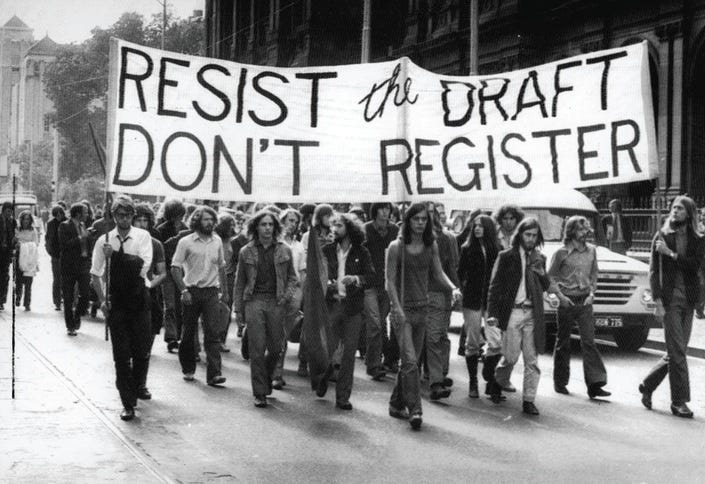The above is from “Alice’s Restaurant” in 1969, the height of the anti-Vietnam War, anti-draft protests. Now the hippies who played the recording of the song, 18-minutes long, and saw the movie, are running the country, including the wars in Ukraine, Iraq, Niger, Syria, etc. And Vietnam now is a capitalist country which Joe “Five Deferments” Biden just visited.
For the first time in decades the U.S. military is talking about restoring a military draft to fill the ranks. Look at this: “Large-scale combat operations troop requirements may well require a reconceptualization of the 1970s and 1980s volunteer force and a move toward partial conscription.”
That’s from “A Call to Action: Lessons from Ukraine for the Future Force,” by Katie Crombe John A. Nagl, in the August number of the U.S. Army War College Quarterly: Parameters. It’s worth reading all 30 pages, as it includes lessons learned from the extremely bloody Ukraine War. Here’s a link: tinyurl.com/ypcvc5v4
My cohort of guys born in 1955 was the first of the Vietnam War era not to face the draft lottery, although we had to register. As younger people know from newsreels of the 1960s and 70s, the draft was highly divisive. President Nixon finally withdrew all U.S. troops by 1973. The move to the all-volunteer force began the military’s rebuilding.
I was part of that when I joined the U.S. Army, 1978-82. It was refashioned away from war in the jungles and rice paddies of Southeast Asia, into a mobile, armored force aimed at preventing the immense Soviet Army from invading through the Fulda Gap in Germany. That worked. We kept the peace.
In 1991, the Soviet Union collapsed and the Red Army went home. That U.S. military remained intact in 1991 when it was shipped to the Middle East and cut through Saddam Hussein’s Soviet-equipped forces like a hot knife through butter. After 9/11 struck in 2001, the military became highly specialized and emphasized fighting terrorists, or much inferior militaries such as Saddam Hussein’s in 2003.
The military already is changing again, as Crombe and Nagle detail. And has to change radically for a potential facedown with Russia or China. Which of course we must hope never happens. The Ukraine War more resembles the static artillery standoffs of World War I than the tank maneuver warfare of World War II.
“Army theater medical planners may anticipate a sustained rate of roughly 3,600 casualties per day, ranging from those killed in action to those wounded in action or suffering disease or other non-battle injuries,” write the authors. In the 20 years of the Afghanistan and Iraq Wars, total casualties were 50,000. Or seven per day.
A big problem now is recruiting. This month the Air Force reported it missed its recruiting target for the first time since 1999, falling 10% short. The Army will fall 23% short and the Navy, 26%. The Marines made theirs. Much of the problem stems from 77% of kids 17-24 being mentally or physically unfit for service.
The Individual Ready Reserve are troops who have mustered out, but still have some years on their contracts. Usually you don’t have to do anything except take an occasional call from a recruiter. When I enlisted, it was six years total; commonly four years active, two IRR. Now it’s eight years total. President Biden, who got five deferments from the Vietnam War draft, in July called up 3,000 IRR troops for the needs of training and supplying the Ukrainian Army.
According to Crombe and Nagle, the IRR has fallen from 700,000 in 1973 to 76,000. “The implication is that the 1970s concept of an all-volunteer force has outlived its shelf life and does not align with the current operating environment.”
The bulk of their paper describes how technological changes make everything on the battle field visible, therefore easy targets. “Dramatically increased casualty rates, with resulting implications for force structure and manning requirements, are just one of the many dramatic changes in the character of war. The ubiquitous use of unmanned aerial vehicles, unmanned surface vehicles, satellite imagery, sensor-based technologies, smartphones, commercial data links, and open-source intelligence is fundamentally changing the way armies will fight.”
Which they say suggests the all-volunteer force “has reached its obsolescence.”
How will Americans react to the military calling for conscription? What will the politicians do? We could see youngsters marching in the streets, locking arms and inhaling doobies with their gray, hippie grandparents, shouting, “Hell, no, we won’t go!”





I am not an American, but I suspect this wouldn’t fly. There would be fairness issues with targeting the most able quarter of young people, whose parents have invested the most. Furthermore the rationale that they are needed for the meat grinder is unappealing.
I see some parallels with the concerns over care for the elderly and a lack of willing and able adult children to care for them. I understand there has been talk in Germany over some form of national service that could involve elder care.
Incidentally, in the 1990s the Ontario conservative government instituted 40 mandatory volunteer hours to graduate high school. It hasn’t been repealed.
Basically it seems like the older generations didn’t reproduce enough and are now preying on the young. Not a happy thought for me as a parent.
What I expect will instead happen is mass importation of foreigners.